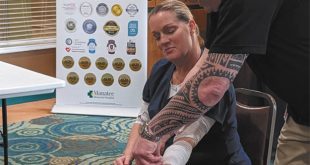By Dr. Isin Mustafa, DPM, MSHS, DABPM, FACPM


So who is at risk for melanoma? Anyone can have melanoma, including people with dark skin. However, there are characteristics that increase you risk of developing melanoma these include but are not limited to: having a fair complexion (people with freckles, light colored eyes or red hair), being exposed to natural sunlight or artificial sunlight; being exposed to certain factors in the environment ( solvents, vinyl chloride, and PCBs); having a history of repeated sun burns; having several large or many small moles; having a family history of skin cancer; having a history of skin cancer; and having genetic predisposition.
Since early detection is crucial it’s important for you to know what to look for. Performing routine foot exams will reduce the risk of your melanoma on the foot or ankle going undiagnosed. There are four signs to look for when examining your feet or other parts of your body for melanoma. These four signs are known as the ABCDs of melanoma (asymmetry, border, color, and diameter). These signs will help you when performing self-inspection of moles and other unusual spots on your feet. When performing self-inspection of the foot make sure you examine your toe nails for discoloration as well as between your toe. You may even want to take pictures to have as a way to compare their appearance overtime. If any of these signs are present on the foot, it is important to see a specialist right away.
In addition to performing routine self-inspection there are other precautionary measures one may utilize to reduce the risk of melanoma these include: wearing water shoes or socks with shoes,
using adequate sunscreen including on the soles and top of your feet, Inspect all areas of the feet daily, including the soles, underneath toenails and between the toes, remove nail polish to examine underneath your nail, avoid UV radiation during the sun’s peak hours (10:00am to 4:00pm) beginning at birth( sun exposure is especially damaging to children and adolescents), wear sunglasses that block 100 percent of all UV rays (UVA and UVB), and wear a wide-brimmed hat.


Border — Border irregularity often indicates melanoma. The border, or edge, is typically ragged, notched or blurred.
Color — Melanoma is typically a mix of colors or hues, rather than a single, solid color.
Diameter — Melanoma grows in diameter, whereas moles remain small. A spot that is larger than 5 millimeters (the size of a pencil eraser) is cause for concern.
Remember, early detection is crucial with malignant melanoma. If detected and treated before it spreads, the 5-year survival rate is over 95%. If you see any of the ABCD signs or if you have discoloration beneath a toenail be sure to visit a foot and ankle surgeon as soon as possible.
Isin Mustafa, DPM, is a Podiatrist at Family Foot & Leg Centers in Sarasota, FL. She is a Fellow of the American College of Foot & Ankle Surgeons.
Call 239-430-3668 or visit www.NaplesPodiatrist.com to make an appointment. Visit FootHealthFacts.org to learn more about foot and ankle conditions.
Family Foot and Leg Center
3110 Fruitville Commons Blvd,
Suite 102
Sarasota, FL 34240
(239) 430 – 3668 (FOOT)
www.NaplesPodiatrist.com
Disclaimer: This content is not intended to be a substitute for professional medical advice, diagnosis, or treatment. Always seek the advice of your physician or other qualified health care provider with any questions you may have regarding a medical condition.
 Southwest Florida's Health and Wellness Magazine Health and Wellness Articles
Southwest Florida's Health and Wellness Magazine Health and Wellness Articles

